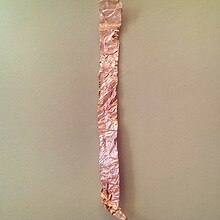Copper foil

Copper foil is a thin sheet of copper metal that is widely used in various applications due to its excellent electrical conductivity, malleability, and corrosion resistance. It is an essential material in the electronics industry, especially for manufacturing printed circuit boards (PCBs) and other electronic components.[1]
Manufacturing process
The manufacturing of copper foil involves several steps, including casting, rolling, annealing, and finishing. The process starts with molten copper being cast into large slabs, which are then rolled down to the desired thickness. During the rolling process, the copper undergoes annealing, a heat treatment that improves its flexibility and removes any internal stresses.
Once the copper reaches the desired thickness, it is further processed to achieve specific surface qualities, such as matte, half-matte, or shiny finishes. The finished copper foil is then spooled into rolls of varying widths and lengths, depending on the intended application.[2]
Types
Copper foil is available in different types to suit various applications. The most common types include:[3][4]
- Electrodeposited Copper Foil
Electrodeposited copper foil, also known as electrolytic copper foil, is produced by electroplating copper onto a rolling drum in a highly controlled manner. This type of copper foil has uniform thickness and excellent electrical conductivity, making it ideal for high-performance electronic applications.
- Rolled Annealed (RA) Copper Foil
Rolled Annealed copper foil is produced through a rolling and annealing process, as described earlier. It offers good flexibility and is commonly used in flexible printed circuit boards (PCBs) and other applications where flexibility is required.
- High-Temperature Rolled Annealed (HTRA) Copper Foil
High-Temperature Rolled Annealed copper foil is similar to RA copper foil but undergoes additional heat treatment to enhance its resistance to high temperatures. This type of copper foil is used in applications that involve exposure to elevated temperatures.
- Ultra-Thin Copper Foil
Ultra-thin copper foil is an extremely thin variant used in specialized applications where space is limited, such as in RFID tags and smart cards.
Applications
Copper foil has a wide range of applications, with its primary use being in the electronics industry. Some of the major applications include: [5]
- Printed Circuit Boards (PCBs)
Copper foil is a crucial component in the manufacturing of PCBs, which are the building blocks of electronic devices. It is used to create conductive traces and interconnections on the insulating substrate, allowing the flow of electrical signals between different components.
- Lithium-Ion Batteries
Copper foil is utilized in lithium-ion batteries as a current collector. It enhances the battery's performance by providing a conductive pathway for the flow of electrons during charging and discharging processes.
- Electromagnetic Shielding
Due to its high electrical conductivity, copper foil is employed for electromagnetic shielding in various electronic devices. It helps prevent electromagnetic interference (EMI) and radio frequency interference (RFI), ensuring proper device operation.
- Stained Glass Art
In artistic applications, copper foil is used in stained glass artwork to join individual glass pieces together, providing structural support and creating decorative elements.
- Electrical Transformers
Copper foil is utilized in the winding of electrical transformers due to its low electrical resistance, ensuring efficient power transmission and minimizing energy loss.
